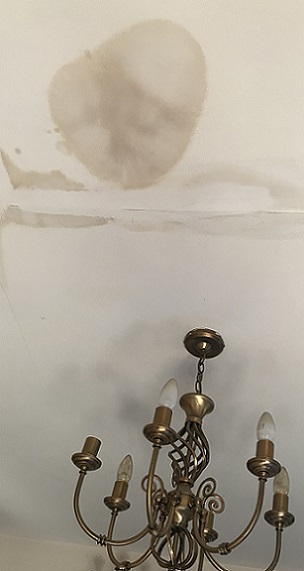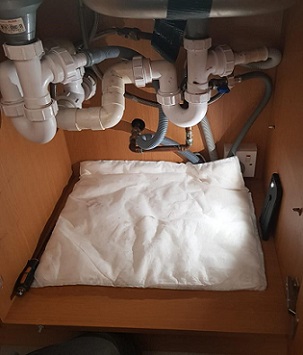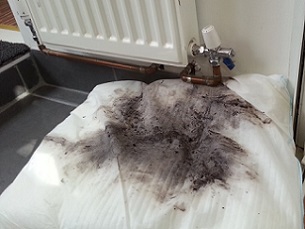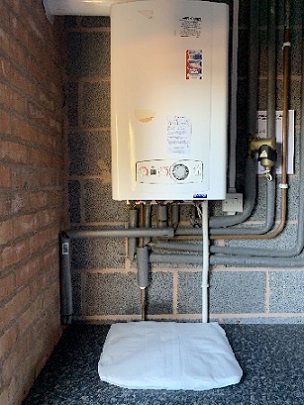 A nasty-looking watermark on a ceiling caused by a leaking shower above
A nasty-looking watermark on a ceiling caused by a leaking shower above
 Spaghetti junction of plumbing under a kitchen sink protected by FloodSax
Spaghetti junction of plumbing under a kitchen sink protected by FloodSax
 Water leaking from a radiator onto a FloodSax
Water leaking from a radiator onto a FloodSax
 Boilers can often spring a leak. Best be prepared with a FloodSax
Boilers can often spring a leak. Best be prepared with a FloodSax
What are the most common causes of floods inside homes and businesses?
Floods are incredibly costly to business and homeowners … but you may be surprised at just how vulnerable your home is to being damaged by floodwater and how intensely irritating this can be.
After all, is there anyone reading this who hasn’t had a flood or leak inside their house?
Everyone knows the danger of a burst pipe but that’s just one way water could cause some serious damage to your home or business.
Water is merciless … and by that we mean it wrecks everything it touches.
This is why any plumbing leaks and spills need sorting quickly before they turn into a major flooding problem and why everyone should have something to deal with a flood instantly such as FloodSax which absorbs water quickly to prevent any damage from spreading. Use it to mitigate the damage before a plumber arrives – FloodSax are so thin with a large surface area they can be slipped beneath pipes and even under floorboards.
Just add water (how ironic is that?) by immersing them in it and they transform into instant alternative sandbags to keep floodwater getting in from outside. Find out more at http://www.floodsax.co.uk/
So, here goes, the many weird and certainly not wonderful ways you could find your home damaged by floodwater.
Frozen pipes: Never turn all your heating off in winter – if water freezes in your pipes it expands, cracks the pipe and when it thaws it all comes flooding out. Common sense, really, that one, but with energy bills going through the roof, the sky and the stratosphere, this will sadly probably happen more and more.
Mice, rats and other vermin: Yes, our little rodent chums like nothing better than to gnaw away on a delicious water pipe, often in the most inaccessible places. This can especially happen under the sink and, over time, you can smell the musty aroma of leaking water. Take the kitchen unit kickboards off, have a good look underneath and you may see pipes with tiny holes and water spurting out of them as it passes through. This means the little blighters have been hard at work and, suddenly, live and let live when it comes to mother nature doesn’t seem to be an option. Out comes the poison and mousetraps.
Grouting and seals in showers: Over time water will have an impact on your grout and seals, especially if you enjoy the thrill of a power shower pumped up to maximum effect. The water will hit the same spots in the shower time and time again (not being rude, but where it hits depends on your body shape) and so will take a toll. Once the grout starts to crack and crumble the water will get behind the tiles and then drip down. The first you’ll know about it is when you get a not-so-lovely big watermark on the ceiling below. So the moto is keep an eye on that grout and if it’s crumbling get it out. Obviously, replace it too (but that bit didn’t rhyme). Same with the sealant (which does rhyme).
Pipes that simply give way due to the pressure: Yes, we’re not just talking of the pressure of being a pipe (that would be silly) but the water pressure they can come under. A lot of today’s plumbing involves plastic pipes which simply push together. All very well but if the water pressure coursing through the pipes is increased it can be too much for the fittings and they budge, with water dripping out which may then lead to a full-blown flood. You’d only know this was happening under the floorboards if the boiler keeps losing pressure or you can smell the pungent aroma of water beneath your feet. Pipes can especially be vulnerable if you have a new boiler fitted and the water pressure it pumps out is far greater than the old one.
Washing machines: Seals can give way on the water pipes leading into the machine in time or the pipes could crack if they get damaged – perhaps if you have to move the machine. The seals we are talking about here are the tiny rubber ones, not the furry cuddly ones you see with David Attenborough.
Water pipes leading to large fridge freezers with ice machines: These are usually tucked away at the back so be careful when moving the appliance – they are so heavy if you catch the pipe you could easily crack it.
Toilets: Seals can give way over time in cisterns causing the water to run into the pan continually but there is also the danger this will leak out. Toilet overflows can also go wrong. Very inconvenient from something that’s supposed to be a convenience.
Radiators: Great when they’re working, not so great when they’ve developed a leak which is usually a seal on the pipework going in or out yet it’s not unknown for them to rust, corrode and the water seep out. Often you may not realise for ages if the water is running down onto a dark-coloured carpet.
Pipes under the sink: Kitchen sinks especially can become what we call the spaghetti junction of pipework with pipes coming in and out from everywhere feeding everything from a dishwasher to an outside tap. It’s so easy for them to get caught, tugged or a washer getting worn and the water then drips into the unit or, even worse, through holes in the unit and onto the floor. It then spreads under kitchen floors and before you know it you’ve a hefty repair bill on your hands and a new floor to buy.
Blocked gutters: A blocked gutter on the outside of the house can cause all kinds of flooding problems inside. Debris over the years or a lot of sodden leaves can block the guttering which then sends water over the top and down the side of the property. Water, being water, will then find the quickest and easiest route into the house and perhaps get in where some of the pointing has fallen out. Before you know it you’ve a large damp patch appearing on an internal wall.
Cracked roof slates: Again, once water gets in it finds its quickest course so will run down beams and then drip through ceilings so you might, for instance, find a pool of water on your bathroom floor when it’s raining heavily outside and wonder where on earth that came from. Look up and if you see it dripping through the ceiling you know you’ve got a major problem. Not nice.
Overflowing sinks: Yes, it happens, especially if you have curious little ones in the house who think it’s interesting to see what happens if they put the plug in the sink and then leave the taps on. More expensive than interesting, we’d say. They’ll find their punishments a tad less interesting.
Boilers: Again boilers involve a lot of pipework with seals and valves all at risk of becoming faulty at some point. Be aware that if you see drips of water appear beneath them get the boiler checked out. You can’t afford for it to worsen either in terms of the money you’d have to spend to repair it and the damage it could cause if the drip became a flood. You’d also be without hot water for days or even weeks and that could lead to a lot of unnecessary domestic trouble and strife.
Air conditioning units: We are based in Yorkshire, England, so don’t need air conditioning up here – we tend to just open a window and let all that lovely fresh air in. But if you do have a unit to warm you up or to help you keep your cool it could develop a problem. This is because your air conditioning removes excess moisture from the air in your house outside. If the unit’s ducts clog up, the moisture will accumulate inside them and then trickle down to the floor, damaging it.
Sewage backing up through the toilet: Naturally, we’ve saved the most unpalatable to the last. Floods outside or a toilet blockage (we’ll not go into details but rather let your imagination run riot with this one) sends water and a whole lot more back up and onto your toilet floor. Water’s bad enough. The whole lot more is even worse.